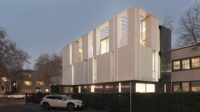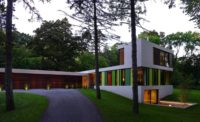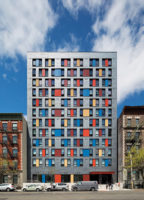In 2001, the Sacramento, California, native now known as Erica Cunningham bought her first fixer-upper house in the city’s Oak Park neighborhood; during the process, she met her future husband, Nathan Cunningham, a contractor. The alignment of Erica’s vision with Nathan’s construction experience naturally led the couple to pursue house flipping, which they eventually parlayed into a business, buying and developing vacant lots that became plentiful and affordable following the 2008 recession. Since then, their company, Indie Capital, has built more than 50 urban-infill houses across Sacramento. Its most recent project, designed by the Milwaukee-based firm Johnsen Schmaling Architects, adds a cluster of nine boxlike single-family houses, each 1,500 square feet, to a long-neglected site near the city’s major freeway, about a fifteen minute walk from the Capitol.
Additional Content:
Jump to credits & specifications
The Broadway Housing project occupies an irregular L-shaped site at the end of a long, slender block between Broadway, a busy thoroughfare with a large cemetery bordering its south side, and the quiet, residential Yale Street, which features a motley arrangement of bungalows, some well kept, with verdant gardens, and others tumbledown. It is this type of modest, eclectic area where the Cunninghams see the most opportunity: “We want to shed light on places that are a little bit on the fringe, that need some energy,” Erica says. Indie Capital’s approach is to regenerate depreciated neighborhoods by injecting midscale market-rate housing that respects context while adding a contemporary allure. With people migrating from the Bay Area, seeking affordability, the couple identified a demand for dwellings with a modern aesthetic. “These professionals are used to a certain level of design that they aren’t seeing here,” explains Erica. Indie Capital also aims to provide financially accessible entry-level housing for locals to buy.
After developing a number of single-family residences, the company started to consider small collections of houses. Frustrated with local architects, who seemed unadventurous in residential design, Erica found the award-winning Johnsen Schmaling firm online. The architects were responsive. “What intrigued us was that the team served as both developer and contractor, which allowed a streamlined budget—there was no third party profiting,” says principal Brian Johnsen. Finding the firm was a “happy accident,” says Erica. “They’re sensitive to our goals, and they get the urban-infill process.”
Broadway Housing is Johnsen Schmaling’s third completed project for Indie Capital. All three are subdivisions of detached six to nine single-family residences, which sell for an average of $500,000 each. As with the firm’s other work with Indie Capital, Broadway Housing’s design responds perceptively to the miscellany of its environment. With units split between tranquil Yale Street and the more urban Broadway strip, the architects needed to “find a formula that responds to both sides but is of the same language,” says principal Sebastian Schmaling.
One way to achieve this was to manipulate the scales of the steel-reinforced wood-framed structures. The six residences facing Yale Street are two stories, each with a driveway and a front yard, to reflect the street’s more suburban context. Inside, at the first level, the combined kitchen, dining, and living area is arranged on the west side, with the garage and storage on the east; the second floor features three bedrooms and an office. The remaining three buildings, on Broadway, which are flanked by a quirky headstone retailer and a vacant parcel, are three stories with two bedrooms. There, by using the garage as a plinth and stacking the living spaces on top, the architects ensured that residents would have views directly out to the cemetery trees instead of onto the roadway. What the Broadway houses lack in bedroom space, they make up for in more generous storage areas.
Despite the difference in massing, the buildings have the same DNA. “Since the forms had to be very simple, we tried to articulate things to make them look more complex than they really are,” Schmaling says. For all the structures, the architects partially extruded the upper levels to create cantilevered window bays, wrapping these “cubes” with cedar cladding and animating them with orange polymer paneling and syncopated fenestration, lending a sense of vitality and surprise to the muted palette of surrounding buildings and lots. Inside, the floor-to-ceiling glazing admits ample natural light while providing dynamic sight lines to the outside. It also lends a sense of verticality that makes the units feel airy and spacious.
Completed earlier this year, all but one unit are occupied. Three blocks away, Indie Capital is working with Johnsen Schmaling on a new housing typology that they hope will offer more financial flexibility for owners—a development with duplexes stacked atop studios that could be rented out to help offset housing expenses. “We try to absorb the lessons learned from each project to guide future development,” says Erica. “We are always trying to get better.”
CreditsArchitect: Johnsen Schmaling Architects — Brian Johnsen, Sebastian Schmaling, principals in charge; Ben Penlesky, Andrew Cesarz, Angelina Torbica, Matt Wendorf, P.J. Murrill, project team
Engineering: Core 4 (structural); KPFF (civil)
General contractor: Indie Capital
Size: 1,500 square feet per building
Cost: $2.8 million
Completion date: February 2019 |
SpecificationsExterior cladding Boral (polymer); Sto (stucco)
Roofing membrane Johns Manville
Doors Simpson Door Company, Sierra Pacific (sliding doors)
Aluminum-clad windows Sierra Pacific
Hardware Inox (locksets, pulls); IKEA (pulls)
Interior finishes Sherwin-Williams (paints and stains); Cosentino (quartz solid surfacing); Daltile, Crossville (floor and wall tile)
Lighting Cooper, Jesco
Plumbing Nameek’s, Grohe, Blanco, Kohler, Moen |












Post a comment to this article
Report Abusive Comment